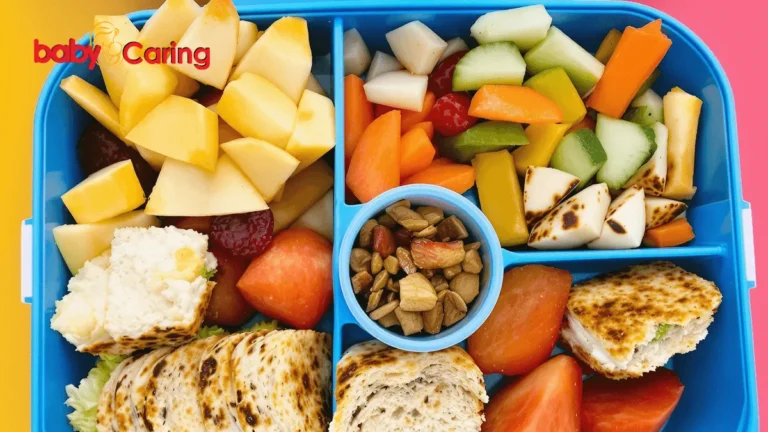
Do you know all the key points of early childhood care in autumn?
The temperature changes frequently in autumn, and children are prone to diseases. Parents need to strengthen their care and take timely precautions. Let’s take a look at what we should pay attention to childhood care in autumn.
1. Maintain hygiene and prevent diarrhea
When babies suddenly have diarrhea in autumn, the disease is mostly of “cold” nature, because babies’ body temperature regulation function is not perfect and they are prone to catching cold. If they happen to eat unhygienic food, especially food contaminated with ” rotavirus “, they will often have diarrhea.
Therefore, special attention should be paid to food hygiene in autumn, especially fruits and vegetables should be washed before feeding to babies. Do not feed your baby too much. Regularly disinfect your baby’s toys and tableware with high temperature to reduce the spread of bacteria and contamination.

2. Drink more water to relieve autumn dryness for childhood care in autumn
Although the air humidity in autumn is not as low as in winter, because the temperature is relatively high, the human body’s metabolism is relatively vigorous and sweating is more, so it is more likely to experience a series of symptoms caused by dehydration.
Babies are susceptible to dryness, which can damage their lungs and cause dry mouth and throat, cough with little phlegm, nosebleeds, and other symptoms of autumn dryness. At this time, you should increase the amount and frequency of water you feed your baby, and let your baby eat fruits such as pears, water chestnuts, and grapes, which can nourish yin and moisten dryness.
3. Eat a balanced diet as childhood care in autumn
Babies have a strong appetite in autumn, when food sources are most abundant. This is a critical period for regulating the baby’s nutritional status.
Pay attention to dietary balance and the intake of various nutrients. You should ensure the intake of protein, fat, carbohydrates, fiber , calcium, phosphorus, etc. For example, eat more cereals, eggs, melons and fruits, and supplement some vegetables and fruits.
4. Wear more clothes moderately as childhood care in autumn
After autumn, the temperature difference between morning and evening becomes larger, and many mothers cannot control the thickness of their babies’ clothes, especially when babies sweat all over after playing in the sun and are easily sick when exposed to the cold wind in the evening.
Therefore, it is a good idea to prepare an extra piece of clothing for your baby so that you can change it at any time. In fact, you can also prepare multiple dry towels for your baby and place towels on the baby’s chest and back. If the baby gets hot during play, touch the baby’s neck first. If the baby is sweating, replace it with a dry towel.
Mothers should be reminded that many cases of babies getting fever in autumn are caused by parents dressing their babies too many clothes, which prevents the heat from dissipating. Therefore, babies’ clothes should be loose, ventilated, and easy for them to move around.
Precaution: Childhood care in autumn
🍂 As the crisp air of autumn settles in, it’s essential to adjust routines and habits to ensure optimal childhood care in autumn. This transitional season brings cooler temperatures, shorter days, and increased exposure to seasonal illnesses, making preventive care more important than ever.
👶 Start by layering your child’s clothing to keep them warm without overheating. Breathable fabrics and easy-to-remove layers help regulate body temperature during fluctuating weather. Hydration is often overlooked in cooler months, so encourage regular water intake even when they’re not sweating.
🧼 With colds and flu on the rise, reinforce handwashing habits and consider boosting immunity through a balanced diet rich in seasonal fruits and vegetables like pumpkins, apples, and carrots. Outdoor play remains vital—just ensure it’s during daylight hours and in safe, dry areas to avoid slips and chills.
🏡 Indoors, maintain a clean, well-ventilated space. Dry air can irritate young lungs, so using a humidifier may help. Also, monitor for signs of seasonal allergies, which can be triggered by mold or pollen.
By staying proactive, parents can make childhood care in autumn both safe and nurturing, allowing little ones to thrive through the season’s changes.
Conclusion
As the crisp air and golden leaves of autumn arrive, it’s essential to adapt early childhood care to meet seasonal needs. From boosting immunity with nutritious seasonal foods to ensuring warmth and comfort through proper clothing, autumn presents unique opportunities to support children’s growth and well-being. Outdoor play remains vital, but with added attention to safety and weather-appropriate routines. Emotional care also takes center stage, as shorter days and changing environments can affect young minds.
By embracing the rhythm of the season and staying mindful of these key aspects, caregivers can create a nurturing, enriching environment that helps children thrive. Ultimately, childhood care in autumn is about blending warmth, attentiveness, and seasonal wisdom to foster resilience and joy during these formative months. Let this season be a time of cozy connection and vibrant development for every child.







